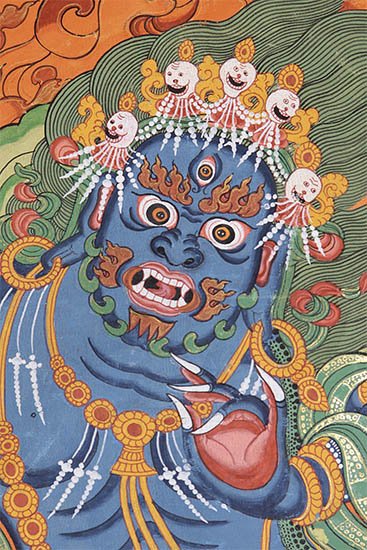Shakamangala, Śakamaṅgala: 1 definition
Introduction:
Shakamangala means something in Buddhism, Pali. If you want to know the exact meaning, history, etymology or English translation of this term then check out the descriptions on this page. Add your comment or reference to a book if you want to contribute to this summary article.
The Sanskrit term Śakamaṅgala can be transliterated into English as Sakamangala or Shakamangala, using the IAST transliteration scheme (?).
In Buddhism
Tibetan Buddhism (Vajrayana or tantric Buddhism)
Source: archive.org: The Indian Buddhist IconographyŚakamaṅgala (शकमङ्गल) is the (Mortal) Bodhisattva associated with by Buddha Krakucchanda: one of the seven mortal Buddhas (mānuṣī) whose names appear last in the list of thirty-two Buddhas in Mahāyāna Buddhism.—The last seven Tathāgatas are well-known, and are designated by the Mahāyānist as Mānuṣī or “Mortal Buddhas”. When represented, the last seven Mortal Buddhas appear all alike; they are of one colour and one form, usually sitting cross-legged,with the right hand disposed in the Bhūmisparśa-mudrā (earth-touching attitute), which is the mudrā peculiar to Akṣobhya. [...] In paintings, the Mortal Buddhas [viz., Krakucchanda and Śakamaṅgala] have usually a yellow or golden complexion. [...] Sometimes they are represented as standing, in which case the appear under a distinguishing Bodhi Tree and with a distinguishing mudrā.
Śakamaṅgala is brought into existence by the (Mortal) Buddha Krakucchanda with his (Mortal) Buddhaśakti named Kakudvatī.

Tibetan Buddhism includes schools such as Nyingma, Kadampa, Kagyu and Gelug. Their primary canon of literature is divided in two broad categories: The Kangyur, which consists of Buddha’s words, and the Tengyur, which includes commentaries from various sources. Esotericism and tantra techniques (vajrayāna) are collected indepently.
See also (Relevant definitions)
Full-text: Kakudvati, Krakucchanda, Manushi.
Relevant text
No search results for Shakamangala, Śakamaṅgala, Sakamangala; (plurals include: Shakamangalas, Śakamaṅgalas, Sakamangalas) in any book or story.